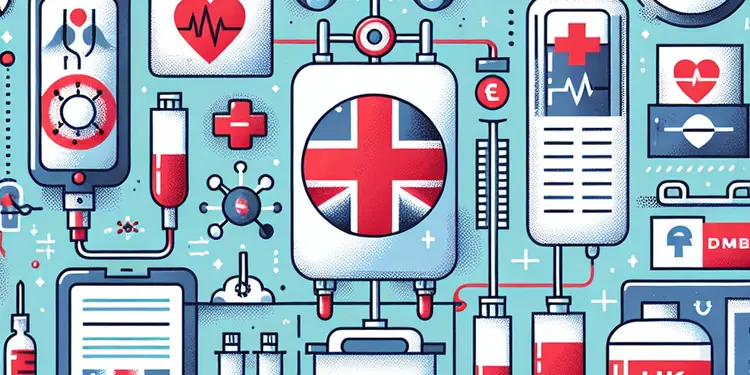
Find Help
More Items From Ergsy search
-

How is obesity measured?
Relevance: 100%
-

Obesity
Relevance: 73%
-

What causes obesity?
Relevance: 57%
-

What health risks are associated with obesity?
Relevance: 57%
-

Are there any societal factors that contribute to obesity?
Relevance: 56%
-

Is childhood obesity a concern in the United Kingdom?
Relevance: 55%
-

What are the current statistics on childhood obesity in the UK?
Relevance: 55%
-

Can genetics influence obesity?
Relevance: 54%
-

How can obesity be prevented?
Relevance: 54%
-

What treatments are available for obesity?
Relevance: 54%
-

What is the impact of obesity on mental health?
Relevance: 52%
-

Is obesity more prevalent in certain regions of the UK?
Relevance: 52%
-

Is childhood obesity a concern in the United Kingdom?
Relevance: 52%
-

Can GLP-1 levels be measured?
Relevance: 51%
-

What role do sugary drinks play in obesity?
Relevance: 50%
-

What impact has the sugar tax had on obesity rates?
Relevance: 49%
-

How important is physical activity in preventing obesity?
Relevance: 48%
-

What role does diet play in managing obesity?
Relevance: 47%
-

Can cortisol levels be measured?
Relevance: 44%
-

How are pollen counts measured?
Relevance: 42%
-

How is progress measured for SEND children?
Relevance: 39%
-

Seven Reaasons For Measuring blood pressure
Relevance: 39%
-

What public health measures are important for managing the plague?
Relevance: 35%
-

What measures are being taken to control Marburg virus outbreaks?
Relevance: 34%
-

What measures are being taken to address water loss in the UK?
Relevance: 34%
-

What measures are taken during a screw worm outbreak?
Relevance: 33%
-

UK Banks Strengthen Security Measures Amid Rise in Online Scams
Relevance: 32%
-

What measures are suggested to substitute the housing benefits?
Relevance: 31%
-

What measures are taken to prevent disease transmission in blood transfusions?
Relevance: 31%
-

What preventive measures can reduce the risk of Nipah Virus infection?
Relevance: 30%
-

What measures are taken to ensure food safety in school meals?
Relevance: 30%
-

What measures are being taken to prevent mosquito-borne diseases in the UK?
Relevance: 29%
-

What condition does Wegovy treat?
Relevance: 26%
-

What first aid measures can be taken in case of methanol exposure?
Relevance: 25%
-

What measures are in place to prevent Zika virus transmission in the UK?
Relevance: 23%
-

What preventive measures can I take to protect my email from being hacked?
Relevance: 23%
-

Has the sugar tax been effective?
Relevance: 22%
-

What are the long-term goals of the sugar tax?
Relevance: 22%
-

What are risk factors for developing sleep apnea?
Relevance: 20%
-

What is the purpose of the sugar tax?
Relevance: 20%
Measuring Obesity: An Overview
Obesity measurement is a crucial aspect of health assessment, especially in the United Kingdom, where obesity levels have been a growing concern. Accurately determining obesity helps in managing and treating this condition effectively. Several methods are used to measure obesity, each with its own advantages and limitations. This guide provides an overview of these methods to offer a clearer understanding of how obesity is assessed.
Body Mass Index (BMI)
Body Mass Index (BMI) is the most commonly used method for assessing obesity. It is a simple, cost-effective tool that calculates a person's weight in relation to their height. The formula involves dividing a person’s weight in kilograms by the square of their height in meters. In the UK, BMI is often used to categorise individuals into various weight statuses: underweight (BMI less than 18.5), healthy weight (BMI 18.5-24.9), overweight (BMI 25-29.9), and obese (BMI 30 or above). While BMI is widely used, it does not take into account muscle mass, bone density, or the distribution of fat, which can sometimes lead to misclassification.
Waist Circumference
Waist circumference is another method used to assess central obesity, which is an important risk factor for cardiovascular diseases. This method involves measuring the circumference around the smallest area of the waist, or if it is not visible, at the navel level. In the UK, a waist circumference of 94 cm or more in men and 80 cm or more in women is considered a risk factor. Unlike BMI, waist circumference provides insight into the level of visceral fat, which is more closely associated with health risks.
Waist-to-Hip Ratio (WHR)
The waist-to-hip ratio (WHR) measures the distribution of body fat by comparing the circumference of the waist to that of the hips. A higher WHR indicates a higher concentration of abdominal fat, which increases health risk. The World Health Organization considers a WHR above 0.90 in men and 0.85 in women to be indicative of a higher risk of obesity-related health issues. This method is significant as it considers where body fat is stored, which is an important determinant of health risks.
Body Fat Percentage
Body fat percentage provides a more direct assessment of an individual's fat content. Methods to calculate body fat percentage include skinfold measurements, bioelectrical impedance analysis, and dual-energy X-ray absorptiometry (DEXA). While these methods can provide a more comprehensive view of body composition, they are often more costly and require specialised equipment, making them less accessible for widespread public health assessments.
Measuring Obesity: An Overview
Obesity is when someone has too much body fat. Knowing if someone is obese is important for their health. In the UK, many people are becoming obese. This guide explains how doctors find out if someone is obese. Different methods have different pros and cons.
Body Mass Index (BMI)
BMI is a common way to see if someone is obese. It is easy and cheap to check. To find BMI, you divide a person's weight by their height. Doctors use numbers to say if someone is underweight, just right, or overweight. But BMI doesn't think about muscles or bones. So, it might not be right for everyone.
Waist Circumference
Measuring the waist is another way to see if someone has too much belly fat. Belly fat can cause heart problems. To measure, wrap a tape around the smallest part of the waist. In the UK, men with a waist bigger than 94 cm and women over 80 cm might be at risk. This way is good because it shows how much fat is in the belly.
Waist-to-Hip Ratio (WHR)
WHR checks where fat is on the body. Measure the waist, then the hips. Divide the waist size by the hip size. A high ratio means more belly fat, which can be bad for health. For men, a ratio over 0.90, and for women, over 0.85 is risky. This way shows how body fat is spread, which is important.
Body Fat Percentage
This checks how much of the body is fat. It can be checked in different ways, like using a special machine or pinching the skin. These ways give a better idea of how much fat is in the body. But they can cost more money and need special tools, so not everyone can use them easily.
Tip: If you find reading difficult, using pictures or talking to a helper might make things easier. You can also use apps to read aloud. Try them out!
Frequently Asked Questions
What is obesity?
Obesity is a condition where a person has accumulated an excessive amount of body fat, which can have a negative impact on their health.
How is obesity measured?
Obesity is commonly measured using the Body Mass Index (BMI), which is a calculation that uses weight and height to classify individuals into different categories based on body fat.
What is BMI?
BMI stands for Body Mass Index. It is a number calculated from a person's weight and height and is used to assess whether an individual is underweight, normal weight, overweight, or obese.
How do you calculate BMI?
BMI is calculated by taking a person's weight in kilograms and dividing it by their height in metres squared. The formula is: BMI = weight (kg) / (height (m))^2.
What BMI range indicates obesity?
According to the World Health Organization and the NHS in the UK, a BMI of 30 or higher is classified as obese.
Are there any limitations to using BMI to measure obesity?
Yes, BMI does not account for muscle mass, bone density, and overall body composition, so it may not accurately reflect body fat percentage in some individuals.
What are other methods to measure obesity besides BMI?
Other methods include waist circumference, waist-to-hip ratio, skinfold thickness measurements, and body fat percentage analysis using bioelectrical impedance or DEXA scans.
Why is waist circumference measurement important?
Waist circumference is important because it helps assess abdominal fat, which can be a better indicator of obesity-related health risks than BMI alone.
What is considered a high-risk waist circumference?
In the UK, a waist circumference greater than 94 cm (37 inches) for men and 80 cm (31.5 inches) for women is associated with a higher risk of health problems.
Can children use BMI to assess obesity?
Yes, but for children and teenagers, BMI is age- and sex-specific and is often referred to as BMI-for-age. It is compared to percentiles to account for growth patterns.
What are BMI percentiles for children?
BMI percentiles for children indicate how a child's BMI compares to a national reference. A BMI at or above the 95th percentile is considered obese for children.
Why is it important to measure obesity?
Measuring obesity is important because it helps identify individuals at risk for health issues such as heart disease, diabetes, and certain cancers, allowing for early intervention.
Is there a difference between being overweight and being obese?
Yes, being overweight means having more body weight than is considered normal for a given height, while obesity refers to having an excessive amount of body fat.
How often should one check their BMI?
It is generally recommended to check your BMI annually as part of a regular health check-up, or more frequently if you are actively managing weight conditions.
Can BMI be used for everyone?
While BMI can be useful for most adults, it may not be suitable for athletes, pregnant women, or the elderly, as it doesn’t differentiate between fat and muscle or account for other factors.
What is being very overweight?
Being very overweight means having too much body fat. It can make it hard to stay healthy. Eating healthy food and moving your body can help. Some people use apps or go to support groups for help.
Obesity means having too much body fat. It can be bad for your health.
How do we measure if someone is very overweight?
We measure body fat using something called Body Mass Index, or BMI for short. BMI is a way to see if someone is a healthy weight. It uses a person's weight and height to help decide.
What is BMI?
BMI means "Body Mass Index." It is a number that tells if a person's weight is healthy. BMI helps us know if someone is underweight, normal weight, or overweight. It looks at weight and height together.
To check your BMI, you can use a BMI calculator. This tool is easy to find online. You just put in your weight and height, and it gives you the number. Ask a grown-up to help you if you need it.
Remember, if you have questions about your weight or health, it is always good to talk to a doctor or a nurse. They can give you the best advice.
BMI means Body Mass Index. It is a number we get from someone's weight and height. We use it to see if a person is too thin, normal weight, too heavy, or very heavy.
How can you find out your BMI?
BMI helps us understand if a person is a healthy weight. To find BMI, use this: Take how much someone weighs (in kilograms). Then, divide it by the person's height (in meters) times itself again. This is written like this: BMI = weight (kg) / (height(m) × height(m)).
What BMI number shows someone is obese?
The World Health Organization and the NHS in the UK say that if your BMI is 30 or more, it means you are obese.
Can we always trust BMI to tell us if someone is too heavy?
Sometimes BMI might not give the full picture. Here are some things to think about:
- Muscle: People with lots of muscles, like athletes, might have a high BMI, but they are not unhealthy.
- Growth: Kids and teenagers grow in different ways, so BMI might not be perfect for them.
- Health: BMI doesn’t tell us about other health issues or how strong a person is.
Tools that can help:
- Talk to a doctor to understand more about health.
- Use other tests to learn more, like measuring waist size.
Yes, BMI can be confusing. It doesn't tell us how much muscle or bone someone has. It also doesn't show how much body fat a person has. So, it might not be right for everyone.
What are other ways to check if someone is overweight besides using BMI?
There are other ways to measure body fat:
- Measure around the waist.
- Compare the waist and hip size.
- Pinch skin to check how thick it is.
- Use special devices to check body fat, like bioelectrical machines.
- Use a special scan called a DEXA scan.
If you find reading hard, try using tools that read out words to you.
Why is it important to measure your waist?
Measuring your waist size is important. It helps us see how much fat is around your belly. This can be a better way to know if you might have health problems related to being overweight than just using BMI (Body Mass Index).
What is a high-risk waist size?
In the UK, if a man's waist is more than 94 cm (37 inches), it can mean more health problems.
If a woman's waist is more than 80 cm (31.5 inches), it can also mean more health problems.
Helpful tip: Use a tape measure to check your waist size.
Can kids use BMI to check if they are too heavy?
BMI is a tool that helps us know if someone is the right size for their height. Kids can use BMI, but it's good to have an adult help them, like a parent or doctor.
Here are some tips to make it easier:
- Ask a grown-up to explain what BMI is.
- Use a simple BMI calculator for kids online.
- Talk to a doctor or nurse if you're worried about your size.
Yes, but for kids and teenagers, BMI is different. It is special for their age and whether they are a boy or a girl. It is called BMI-for-age. We look at it and compare it to other kids the same age to see how they are growing.
What is BMI for kids?
BMI means Body Mass Index. It helps tell if a child is a healthy size.
BMI percentiles show how a child's size is compared to other kids of the same age and gender.
You can ask a doctor or nurse to help you find out more about BMI for kids.
You can use online tools with a grown-up to check BMI percentiles for children.
BMI percentiles help us see how a child's body weight is compared to other kids in the country. If a child's BMI is at or above the 95th number, doctors say the child is obese.
To better understand, caregivers can use pictures and charts. Talking with a doctor or nurse can also help.
Why do we need to know if someone is too heavy?
Measuring obesity is important. It helps find people who might get sick. Being too heavy can lead to heart problems, diabetes, and some cancers. Finding out early means they can get help sooner.
Is there a difference between being overweight and being obese?
Let's talk about what overweight and obese mean.
If someone is overweight, it means they weigh more than what is healthy for their height.
If someone is obese, it means they weigh much more than what is healthy for their height. This is more serious.
Both can affect health, so it’s good to talk to a doctor if you are worried.
Tip: You can use pictures or talk to someone you trust to help understand better.
Yes, being overweight means someone weighs more than what's normal for their height. Obesity means having too much body fat.
How often should you check your BMI?
BMI stands for Body Mass Index. It helps show if you are a healthy weight. It's good to check your BMI sometimes to see how your body is doing.
Here are some tips:
- Check your BMI a few times each year.
- You can ask a doctor to help you check it.
- There are online tools that can help check your BMI too.
Remember, it's important to eat healthy and stay active!
It's a good idea to check your BMI once a year when you have a health check-up. If you are trying to lose or gain weight, you might want to check it more often.
Is BMI for Everyone?
BMI means Body Mass Index. It helps to know if your weight is healthy.
BMI may not work for everyone:
- Kids have special charts for growth.
- Muscles can make BMI high, but muscles are healthy.
- Older people need different ways to check health.
If unsure, ask a doctor or nurse for help.
BMI can be helpful for most grown-ups. But it is not always right for athletes, pregnant women, or older people. This is because BMI does not tell the difference between fat and muscle. It also doesn't think about other important things.
Useful Links
- Ergsy carfully checks the information in the videos we provide here.
- Videos shown by Youtube after a video has completed, have NOT been reviewed by ERGSY.
- To view, click the arrow in centre of video.
- Most of the videos you find here will have subtitles and/or closed captions available.
- You may need to turn these on, and choose your preferred language.
- Go to the video you'd like to watch.
- If closed captions (CC) are available, settings will be visible on the bottom right of the video player.
- To turn on Captions, click settings .
- To turn off Captions, click settings again.
More Items From Ergsy search
-

How is obesity measured?
Relevance: 100%
-

Obesity
Relevance: 73%
-

What causes obesity?
Relevance: 57%
-

What health risks are associated with obesity?
Relevance: 57%
-

Are there any societal factors that contribute to obesity?
Relevance: 56%
-

Is childhood obesity a concern in the United Kingdom?
Relevance: 55%
-

What are the current statistics on childhood obesity in the UK?
Relevance: 55%
-

Can genetics influence obesity?
Relevance: 54%
-

How can obesity be prevented?
Relevance: 54%
-

What treatments are available for obesity?
Relevance: 54%
-

What is the impact of obesity on mental health?
Relevance: 52%
-

Is obesity more prevalent in certain regions of the UK?
Relevance: 52%
-

Is childhood obesity a concern in the United Kingdom?
Relevance: 52%
-

Can GLP-1 levels be measured?
Relevance: 51%
-

What role do sugary drinks play in obesity?
Relevance: 50%
-

What impact has the sugar tax had on obesity rates?
Relevance: 49%
-

How important is physical activity in preventing obesity?
Relevance: 48%
-

What role does diet play in managing obesity?
Relevance: 47%
-

Can cortisol levels be measured?
Relevance: 44%
-

How are pollen counts measured?
Relevance: 42%
-

How is progress measured for SEND children?
Relevance: 39%
-

Seven Reaasons For Measuring blood pressure
Relevance: 39%
-

What public health measures are important for managing the plague?
Relevance: 35%
-

What measures are being taken to control Marburg virus outbreaks?
Relevance: 34%
-

What measures are being taken to address water loss in the UK?
Relevance: 34%
-

What measures are taken during a screw worm outbreak?
Relevance: 33%
-

UK Banks Strengthen Security Measures Amid Rise in Online Scams
Relevance: 32%
-

What measures are suggested to substitute the housing benefits?
Relevance: 31%
-

What measures are taken to prevent disease transmission in blood transfusions?
Relevance: 31%
-

What preventive measures can reduce the risk of Nipah Virus infection?
Relevance: 30%
-

What measures are taken to ensure food safety in school meals?
Relevance: 30%
-

What measures are being taken to prevent mosquito-borne diseases in the UK?
Relevance: 29%
-

What condition does Wegovy treat?
Relevance: 26%
-

What first aid measures can be taken in case of methanol exposure?
Relevance: 25%
-

What measures are in place to prevent Zika virus transmission in the UK?
Relevance: 23%
-

What preventive measures can I take to protect my email from being hacked?
Relevance: 23%
-

Has the sugar tax been effective?
Relevance: 22%
-

What are the long-term goals of the sugar tax?
Relevance: 22%
-

What are risk factors for developing sleep apnea?
Relevance: 20%
-

What is the purpose of the sugar tax?
Relevance: 20%


